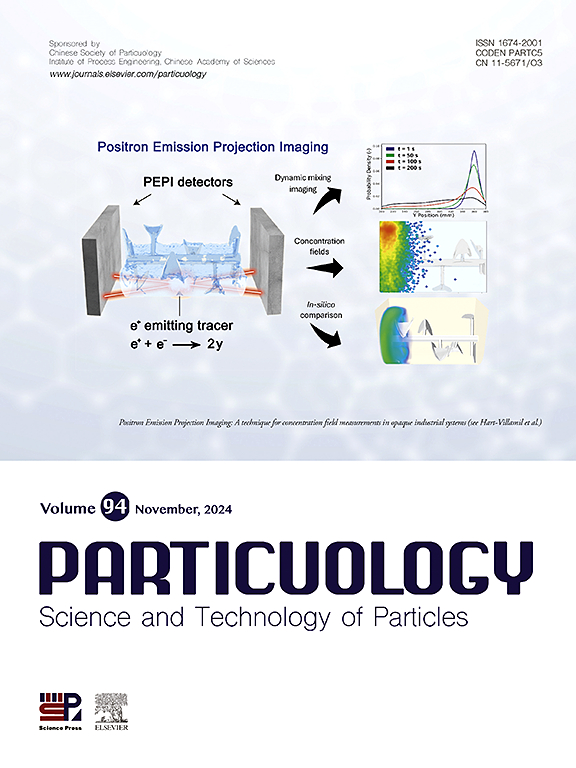利用膨胀-收缩阵列的弯曲微通道协同增强惯性粒子聚焦
IF 4.1
2区 材料科学
Q2 ENGINEERING, CHEMICAL
引用次数: 0
摘要
粒子聚焦,将随机分散的粒子组织成流线,对粒子计数、富集和检测至关重要。该工艺广泛应用于疾病诊断、生化检测、环境监测等领域。我们设计了一个弯曲的微通道,其内部具有集成的矩形伸缩阵列。我们的设计与传统技术不同,利用了基于独特几何结构的两种结构诱导的Dean流的协同效应,从而显著提高了粒子聚焦效率。通过实验与仿真相结合,验证了组合微通道的聚焦性能,并阐明了惯性聚焦机理。在雷诺数为83.33时,一个4.34 cm长的微通道可以实现10 μm颗粒的完全聚焦,这是目前设计的一个进步。此外,我们的研究还发现了一个新的现象:聚焦宽度随着膨胀区的宽度先减小后增大,而膨胀区的长度导致聚焦宽度逐渐减小,直到达到一个稳定的点。通过结构优化,在雷诺数为50时,10 μm颗粒的无量纲聚焦宽度从0.102减小到0.065,5 μm和15 μm颗粒可以完全聚焦,突出了其在各种粒径范围内的适应性和优异性能。这项研究不仅促进了对粒子聚焦动力学的理解,而且为开发更高效、更通用的微流控装置铺平了道路。本文章由计算机程序翻译,如有差异,请以英文原文为准。

Synergistically enhancing inertial particle focusing using a curved microchannel with expansion-contraction arrays
Particle focusing, which organizes randomly dispersed particles into streamlines, is crucial for particle counting, enrichment, and detection. This process is widely applied in disease diagnosis, biochemical testing, and environmental monitoring. We designed a curved microchannel featuring integrated rectangular expansion-contraction arrays on its inner side. Our design diverges from conventional techniques by harnessing the synergistical effect of Dean flow induced by both structures based on the unique geometric configuration, resulting in a marked improvement in particle focusing efficiency. We validated the focusing performance of the combined microchannel and elucidated inertial focusing mechanisms by integrating experiments with simulations. At a Reynolds number of 83.33, a 4.34-cm-long microchannel can achieve the complete focusing of 10-μm particles, representing an advancement over current designs. Furthermore, our research uncovers a novel observation: the focusing width initially decreases with the expansion region's width and then increases, while the length of the expansion region leads to a gradual decrease in focusing width until it reaches a stable point. Through structural optimization, the dimensionless focusing width of 10-μm particles was reduced from 0.102 to 0.065 at a Reynolds number of 50, and particles of 5 and 15 μm can be completely focused, highlighting its adaptability and exceptional performance across a range of particle sizes. This study not only advances the un1derstanding of particle focusing dynamics but also paves the way for the development of more efficient and versatile microfluidic devices for a multitude of applications.
求助全文
通过发布文献求助,成功后即可免费获取论文全文。
去求助
来源期刊

Particuology
工程技术-材料科学:综合
CiteScore
6.70
自引率
2.90%
发文量
1730
审稿时长
32 days
期刊介绍:
The word ‘particuology’ was coined to parallel the discipline for the science and technology of particles.
Particuology is an interdisciplinary journal that publishes frontier research articles and critical reviews on the discovery, formulation and engineering of particulate materials, processes and systems. It especially welcomes contributions utilising advanced theoretical, modelling and measurement methods to enable the discovery and creation of new particulate materials, and the manufacturing of functional particulate-based products, such as sensors.
Papers are handled by Thematic Editors who oversee contributions from specific subject fields. These fields are classified into: Particle Synthesis and Modification; Particle Characterization and Measurement; Granular Systems and Bulk Solids Technology; Fluidization and Particle-Fluid Systems; Aerosols; and Applications of Particle Technology.
Key topics concerning the creation and processing of particulates include:
-Modelling and simulation of particle formation, collective behaviour of particles and systems for particle production over a broad spectrum of length scales
-Mining of experimental data for particle synthesis and surface properties to facilitate the creation of new materials and processes
-Particle design and preparation including controlled response and sensing functionalities in formation, delivery systems and biological systems, etc.
-Experimental and computational methods for visualization and analysis of particulate system.
These topics are broadly relevant to the production of materials, pharmaceuticals and food, and to the conversion of energy resources to fuels and protection of the environment.
 求助内容:
求助内容: 应助结果提醒方式:
应助结果提醒方式:


